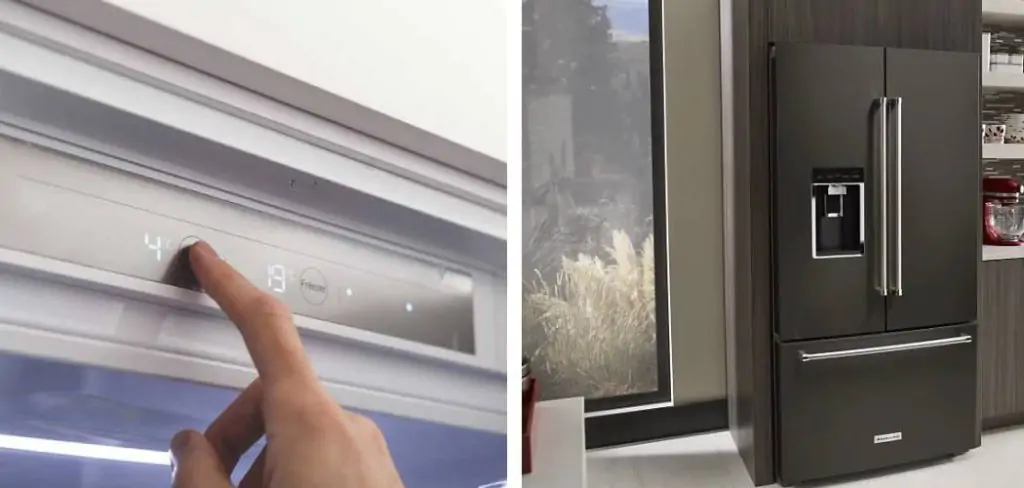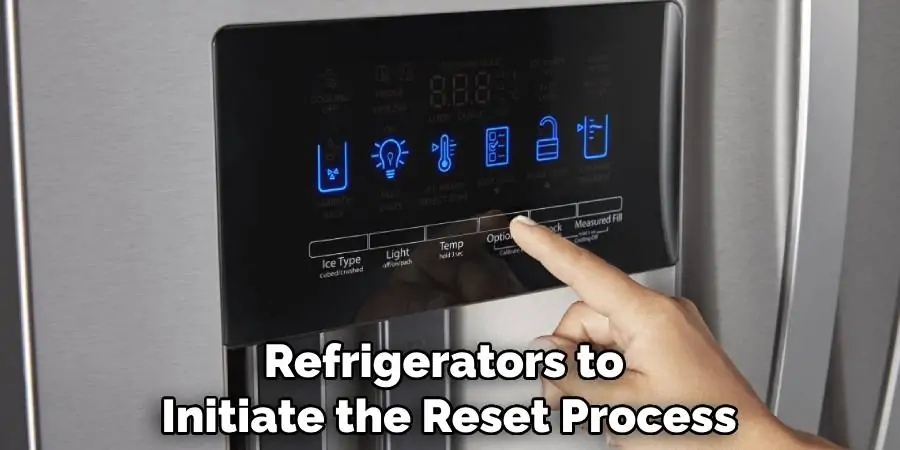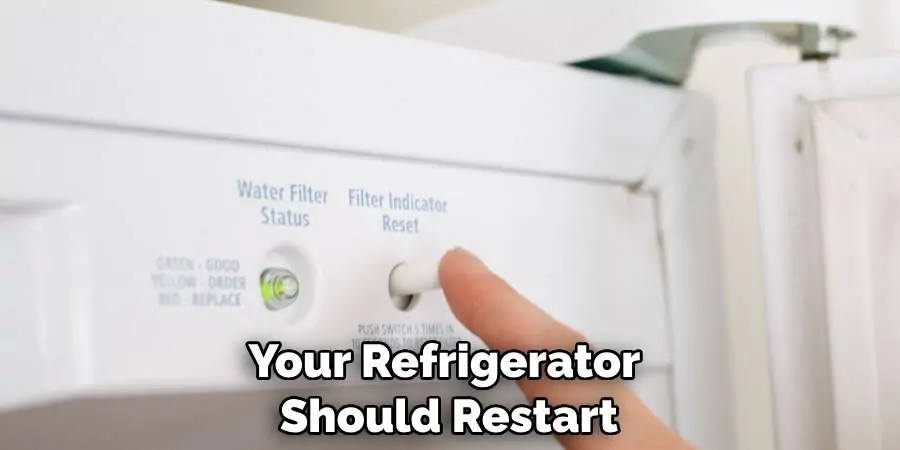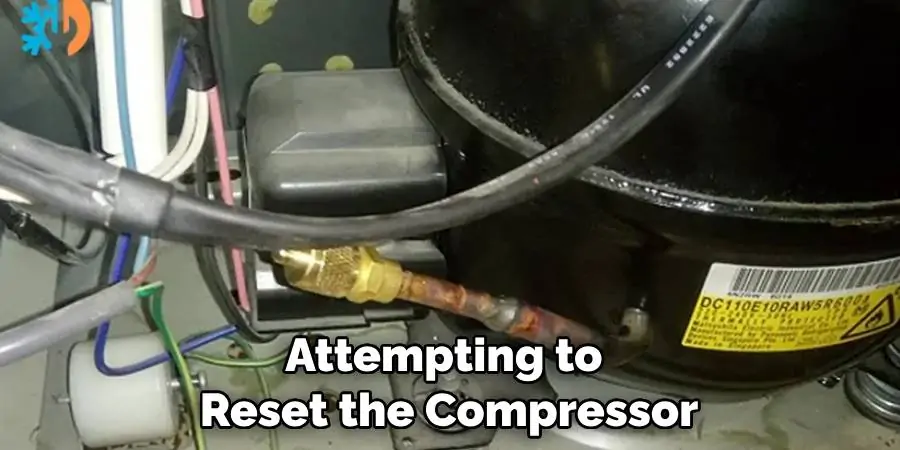Do you feel like your Kitchenaid refrigerator has been acting up lately? Maybe it’s no longer keeping your food fresh or producing ice as efficiently as before. Or perhaps, you’re seeing error codes popping up on the display panel and you’re not sure what to do. Whatever the case may be, don’t panic!
Before calling a technician or shelling out money for a new fridge, there are some simple troubleshooting steps that can potentially solve the issue – resetting your Kitchenaid refrigerator. In this blog post, we’ll guide you through the process on how to reset kitchenaid refrigerator safely and effectively to help get it back in top working condition. So grab a cup of coffee and let’s dive into our step-by-step guide on how to reset your Kitchenaid refrigerator!

Why Resetting Your Kitchenaid Refrigerator is Important
Before we get into the steps on how to reset your Kitchenaid refrigerator, let’s first understand why it’s important to do so. Like any other electronic appliance, refrigerators also have their fair share of issues and malfunctions. These can be caused by power surges, software glitches, or simply wear and tear over time. By resetting your refrigerator, you essentially reboot its system and clear any temporary glitches that may be causing the problem. This can save you time and money from having to call a technician or buying a new appliance.
Precautions Before Resetting Your Kitchenaid Refrigerator
Before we jump into the steps on how to reset your Kitchenaid refrigerator, it’s important to take some precautions to ensure your safety and avoid any potential damage to the appliance. Here are some things you should keep in mind:
- Unplug the refrigerator: Before starting any reset process, make sure to unplug the refrigerator from its power source. This will prevent any electric shocks or accidents.
- Empty the freezer and fridge: It’s important to remove all food items from the refrigerator and freezer before resetting it. This will prevent any food from spoiling or getting contaminated in case the reset process takes longer than expected.
- Keep a towel handy: While resetting your refrigerator, there may be some water leaks or spills. Keep a towel nearby to quickly clean up any messes.

Top Essential Steps on How to Reset Kitchenaid Refrigerator
Now that you’re aware of why resetting your Kitchenaid refrigerator is important and have taken the necessary precautions, let’s get into the steps on how to reset it. Follow these easy-to-follow steps:
Step 1: Unplug the Refrigerator
The first step in resetting your Kitchenaid refrigerator is to unplug it from the power source. This will ensure that you do not get electrocuted while working on the appliance. It’s essential to prioritize safety when dealing with electronic appliances. After unplugging, wait for a few minutes to allow any residual electricity to dissipate before proceeding to the next step.
Step 2: Locate the Control Panel
Once you’ve located the control panel, it’s time to interact with it. Here, you’ll find buttons or a touch display that allows you to control the temperature and other settings of your Kitchenaid refrigerator. It might seem daunting at first, but don’t worry, it’s quite intuitive once you get the hang of it. The specific layout and functionality can vary depending on the model of your refrigerator, but generally, you will find a temperature control setting, ice maker control, and often a water filter status.
Step 3: Press and Hold the “Lock” Button
After finding the “Lock” button, you’ll need to press and hold it for about 3 seconds. This is a common step for some models of Kitchenaid refrigerators to initiate the reset process. Pressing and holding this button will turn off all cooling functions in the refrigerator. This may result in the lights going out or the display panel resetting, don’t be alarmed, these are normal occurrences during the reset process.

Step 4: Wait 30 Seconds
After holding down the “Lock” button for about 3 seconds, you need to wait approximately 30 seconds before letting it go. This pause is crucial as it allows the control panel enough time to reset and calibrate itself. During this time, the refrigerator will not function, but don’t worry – this is a normal part of the process and your appliance is not damaged or broken. After the waiting period is over, you can release the “Lock” button.
Step 5: Press “Temperature” Buttons
If your model does not have a “Lock” button, try pressing and holding both “Temperature” buttons simultaneously for about 3 seconds to initiate the reset process. This method is applicable to certain models that use these buttons to control the overall temperature of the fridge and freezer. By pressing and holding them, you’re commanding the refrigerator’s system to reset and recalibrate itself. After releasing the buttons, give the refrigerator a few minutes to complete the reset process before checking if the previous issues have been resolved.
Step 6: Plug Back In
After completing the steps above, you’re ready to plug your Kitchenaid refrigerator back into the power source. Make sure to position the appliance in a way that doesn’t strain or damage the power cord. Once plugged in, your refrigerator should restart with its freshly reset settings. Give it a few minutes to adjust and check whether it’s functioning normally. Remember, it may take several hours for your refrigerator to return to its standard operating temperature, so be patient and allow it to recalibrate.

Step 7: Check for Error Codes
After the reset process, it’s important to check the control panel for any remaining error codes. If you notice any codes still displayed, it’s an indication that the issue persists. Refer to your user manual for a better understanding of these codes. The manual usually contains a list of error codes along with their potential causes and solutions. In case the problem continues, do not hesitate to contact Kitchenaid customer service for further assistance. Remember, it’s always better to seek help from professionals when dealing with persistent appliance issues to prevent further damage.
Step 8: Adjust Settings as Needed
After successfully resetting your Kitchenaid refrigerator, you may need to adjust the temperature and other settings based on your preferences. Locate the control panel and press the “Temperature” buttons to set your desired cooling level for both the refrigerator and freezer compartments. You may also want to adjust the settings for the ice maker, water filter, or any other features your appliance might have. Always refer to the user manual for specific instructions on how to adjust these settings. Remember, it might take some time for the new settings to take effect, so be patient and allow your refrigerator to adjust accordingly.
Step 9: Regular Maintenance
Keeping your Kitchenaid refrigerator running smoothly requires regular maintenance. This not only helps in preserving the condition of your appliance but also allows it to function at its best. The recommended maintenance frequency varies depending on the specific components. For instance, the interior should be cleaned every 3-4 months with a solution of baking soda and warm water. The condenser coils, located at the back of the refrigerator, should be dusted off every 6 months to allow for better heat transfer.
The door seals should also be checked regularly for any signs of wear and tear. If any damages are noticed, the seals should be replaced to prevent cold air from escaping from the appliance. Always refer to your Kitchenaid refrigerator’s user manual for specific maintenance instructions to ensure longevity and optimum performance.

Frequently Asked Questions
Where is reset button on KitchenAid refrigerator?
Resetting your KitchenAid refrigerator can be a bit of a mystery, but fear not, as it’s easier than you may think. If you’re experiencing issues with your refrigerator such as it not turning on or not staying cool like it used to, a simple reset of the system could do the trick. Finding the reset button can be daunting, but it’s typically located on the control panel. Some models require you to hold down the button or buttons for a specific amount of time, while others may have a specific sequence for pressing various buttons. So, knowing how to reset kitchenaid refrigerator can be a lifesaver in those times of need, and it’s always a good skill to have up your sleeve. Remember to always refer to your user manual for specific instructions on how to reset your particular model.
How to Reset Kitchenaid Refrigerator After Power Outage Without?
If your Kitchenaid refrigerator loses power due to a blackout or power outage, it will automatically restart when the power is restored. However, if you encounter any issues with the refrigerator after a power outage, it’s best to follow the steps mentioned above for resetting your appliance. This will allow the system to recalibrate itself and ensure that everything is functioning properly. In case you’re unable to locate a reset button on your specific model, try unplugging the appliance from the power source for a few minutes and then plugging it back in. This can also act as a manual reset and help resolve any issues caused by the power outage.
How Do You Reset the Compressor on a Kitchenaid Refrigerator?
If your Kitchenaid refrigerator is experiencing issues with the compressor, it’s best to seek help from a professional. Attempting to reset the compressor on your own can be dangerous and may further damage your appliance. It’s best to contact Kitchenaid customer service for assistance in this matter. They can guide you through the process or send a technician to repair the issue.

Conclusion
In conclusion, the process of resetting your Kitchenaid refrigerator might seem like a daunting task, but it is actually quite simple and essential for maintaining the longevity and efficiency of your appliance. Remember to always refer to your manual for specific instructions and follow these top essential steps we have discussed today. By regularly resetting your refrigerator, you can ensure that it continues to function at its best, saves you money on energy costs, and avoids any potential damage to your food.
Don’t wait until it’s too late – take the time to reset your refrigerator now and enjoy the benefits in the long run. And if you encounter any issues or have any lingering questions, don’t hesitate to reach out to Kitchenaid customer service for assistance. With these steps in mind, you can confidently reset your Kitchenaid refrigerator and keep it running smoothly for years to come. So don’t delay, go ahead and give your refrigerator the reset it deserves! Remember, a well-maintained appliance leads to a happy household and deliciously fresh food for all. Take control of your kitchen with these easy-to-follow steps on how to reset Kitchenaid refrigerator today!
